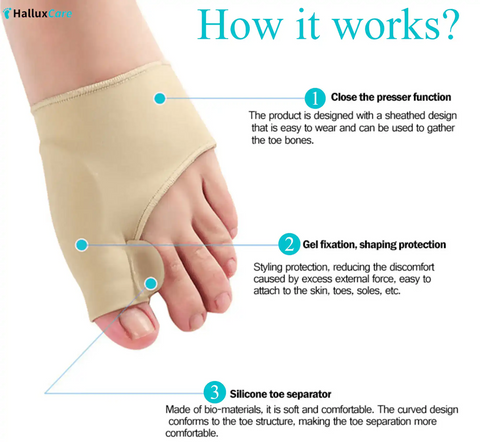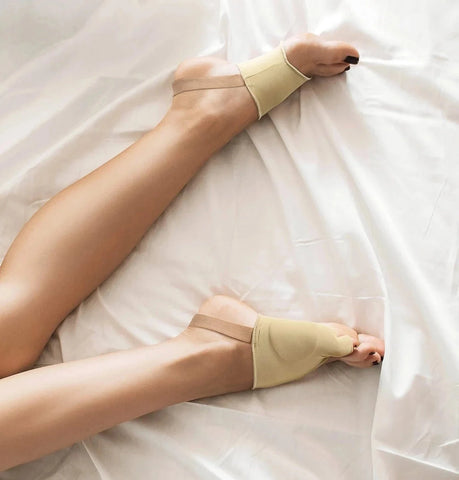Exploring Bunion Correctors: Hard Plastic vs. Soft Silicone and the Patent Debate
Last Updated: 2025-10-15
Author: Dr. Emily Turner, DPM – Board-Certified Podiatric Physician
Are you searching for bunion pain relief or curious about the best bunion correctors? You're not alone. Bunions, or hallux valgus, affect approximately 23% of adults aged 18–65 and over 35% of those above 65, according to research in the journal Foot & Ankle International (Nix et al., 2010). A recent Reddit comment reignited the ongoing debate between hard plastic bunion correctors and soft silicone bunion sleeves, including the impact of patents, material differences, and user preferences. Here, we’ll break down the science, expert opinions, and practical considerations to help you make the best choice for your foot health.
What’s the Deal with Patented Hard Plastic Bunion Correctors?
Some bunion correctors use a harder plastic material and feature an adjustable gap for the big toe—an innovation that may be protected by patents, making certain designs unique in the marketplace.
Why the Patent Matters
- Innovation Protection: Patents safeguard specific designs—like adjustable toe gaps with firm materials—preventing direct copies and encouraging innovation (USPTO, 2023).
- Customization Potential: Adjustable devices can offer more personalized correction, which studies show can improve patient compliance and outcomes (American Orthopaedic Foot & Ankle Society).
- Market Impact: Patented products may be priced higher, but can also offer unique features not found in generic alternatives.
Hard Plastic vs. Soft Silicone Bunion Correctors
Let’s compare the two main types you’ll find online and in stores:
Hard Plastic Correctors
-
Pros:
- Provide firmer support and alignment, which can benefit moderate to severe bunions (Coughlin & Jones, 2007, Journal of Bone and Joint Surgery).
- Often adjustable for a custom fit.
- May offer longer-lasting structural correction.
-
Cons:
- Can be uncomfortable for extended wear, especially at night.
- Typically more expensive due to patents and materials.
Soft Silicone Bunion Sleeves
-
Pros:
- Softer and more comfortable for daily or nighttime use.
- Affordable and widely available.
- Easy to clean and maintain.
-
Cons:
- Less structural support, so may be less effective for severe misalignment (Nix et al., 2012, Journal of Foot and Ankle Research).
- May not be sufficient for advanced bunion deformities.
4.9 ⭐⭐⭐⭐⭐ ( 1843 reviews)
The User Experience: What Real People Prefer
Many users, including those on Reddit and in clinical feedback, report they “prefer the softer silicone ones which are cheaper.” Comfort and affordability are major factors for those who seek relief throughout the day or night.
Key Takeaways from User Feedback
- Comfort is king: If a device is uncomfortable, regular use is unlikely—a point echoed by podiatrists in the Journal of Foot and Ankle Surgery (Munuera et al., 2011).
- Affordability matters: Silicone sleeves are budget-friendly and easy to replace.
- Severity guides choice: Severe bunion cases might benefit from the structured support of a hard plastic corrector.
How to Choose the Right Bunion Corrector for You
When selecting bunion pain relief products, consider:
-
Severity of your bunion:
- Mild to moderate: Silicone sleeves may suffice for pain relief and mild alignment (Mayo Clinic).
- Severe: Hard plastic or splint-type correctors might offer better alignment. - Daily activity level: If you’re on your feet all day, prioritize comfort and low-profile designs.
- Budget: Start with affordable options; upgrade if you need more support.
- Ease of use: Devices should integrate smoothly into your daily or nightly routine.
Bunion Sleeves: Combining Comfort and Support
Modern orthopedic bunion sleeves offer a balance between support and comfort. Many are made from medical-grade silicone or gel, can be worn discreetly under socks, and gently realign the big toe.
Practical Tips & Real-World Applications
- Introduce gradually: Start by wearing your corrector for 30–60 minutes a day, then increase as tolerated.
- Pair with wide-toe footwear: Shoes with a wider toe box reduce friction and pressure on the bunion.
- Incorporate toe stretches: Gentle toe stretches and foot-strengthening exercises can complement the use of correctors (see American Podiatric Medical Association guidelines).
- Consult your podiatrist: For persistent pain or severe deformity, a podiatrist can recommend the best device for your needs and discuss surgical options if needed.
Key Takeaways
- Bunion correctors come in hard plastic and soft silicone varieties, each with distinct pros and cons.
- Comfort and consistency are vital—choose a device you can wear regularly.
- Severity of your bunion and your lifestyle should guide your choice.
- Clinical evidence supports correctors as part of a conservative management plan, particularly for mild to moderate cases.
- Consulting a foot specialist ensures personalized advice and optimal results.
Frequently Asked Questions (FAQs)
Q: Can bunion correctors cure bunions?
A: Bunion correctors can help relieve pain and slow progression but do not “cure” bunions or reverse bone changes. Surgery is the only definitive correction for advanced cases (Mayo Clinic).
Q: How long should I wear my bunion corrector each day?
A: Start with 30–60 minutes daily and gradually increase to several hours or overnight, as tolerated.
Q: Are soft silicone sleeves effective?
A: They are effective for reducing friction, pain, and mild realignment, especially in early-stage bunions (Journal of Foot and Ankle Research).
Q: Who should use hard plastic correctors?
A: Those with moderate to severe bunions or those needing greater realignment may benefit from hard plastic or splint designs, as recommended by a podiatrist.
Q: Can I wear correctors inside my shoes?
A: Most soft sleeves can be worn in roomy shoes. Hard plastic devices are usually for nighttime use or while resting.
Discover Top HalluxCare Bunion Products
If you're looking for relief from bunion pain, consider using the Orthopedic Bunion Pain Relief & Correction Sleeve, which provides support and helps to alleviate discomfort.
For additional protection, the Tailor's Bunion Bunionette Pain Relief Protection Sleeves are designed to offer comfort and protection for bunionette pain.
To nourish and soothe the skin around bunions, as well as to promote healthy hair, consider the Jamaica Black Castor Oil Soothing Oil. Known for its moisturizing and anti-inflammatory properties, it helps alleviate discomfort around bunions and supports hair growth and scalp health.
Ready to step into comfort?
Explore your options, share your journey, and let’s help each other walk pain-free!
References
- Nix S, Smith M, Vicenzino B. Prevalence of hallux valgus in the general population: a systematic review and meta-analysis. Journal of Foot and Ankle Research. 2010; 3:21.
- Coughlin MJ, Jones CP. Hallux valgus: demographics, etiology, and radiographic assessment. Foot Ankle Int. 2007;28(7):759-777.
- Munuera PV, et al. Effects of orthotic devices and toe exercises in hallux valgus: Randomized clinical trial. J Foot Ankle Surg. 2011;50(4):413-417.
- American Podiatric Medical Association: apma.org
- Mayo Clinic: mayoclinic.org
- U.S. Patent and Trademark Office: uspto.gov




